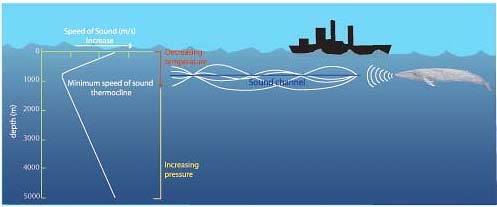

In 1944 the Naval Research Laboratory (NRL) directed reorganization of the Underwater Sound Laboratory at New London for peacetime operation consolidating the Harvard Underwater Sound Laboratory, which had focused on physics of underwater sound, surface ship sonar and weapons systems, in Cambridge, Massachusetts with the New London laboratory. On Jthe New London laboratory's establishment got approval with management by Columbia University for a wide range of antisubmarine warfare work including, passive sonar, ocean acoustics and recording of underwater sounds for that work. Though that laboratory had closed with the end of that war the same criteria and some of the same people advising made New London the logical place to site the East Coast laboratory in response to the Chief, Bureau of Ships, now Naval Sea Systems Command (NAVSEA), Aprequest to the National Defense Research Committee to establish both an East and West coast antisubmarine warfare research laboratory. The Navy, under one of its officers involved in the corporate effort, established the Naval Experimental Station at Fort Trumbull where physicists and engineers, including scientists from nearby universities, worked under the direction of the Special Board on Antisubmarine Devices. The companies, under naval supervision had established an acoustical research station at East Point, Nahant, Massachusetts. New London, Connecticut had been the site of World War I sound research since the establishment of the Naval Experimental Station there as a result of meetings between Navy and the Submarine Signal Company, manufacturer of submarine signals as navigation aids and active in underwater acoustics since establishment in 1901, the Western Electric Company and the General Electric Company. Pier area, Naval Experimental Station, New London circa 1918. In 1992, the command was reorganized as the Naval Undersea Warfare Center, Division Newport. was combined with the Newport facility to form the Naval Underwater Systems Center or NUSC. That year, the Underwater Sound Laboratory from New London, Conn. In 1951, the station on Goat Island was reorganized:įor the next 15 years, it was the Underwater Ordnance Station, and then the Underwater Weapons Research and Engineering Station until 1970. The Naval Torpedo Station researched and tested underwater weaponry through World Wars I and II, creating additional facilities on Rose Island, Fox Island, and Gould Island. The Torpedo Station designed the Mark VI magnetic influence fuze for torpedoes during the 1920s. The torpedo factory became a major employer in the Newport area, as Rhode Island congressmen protected it from competition.

Ī factory was built in 1907 to manufacture steam torpedoes for the Navy. The Army adopted the Navy formulation in 1908 and began manufacture at Picatinny Arsenal. During the 1890s, Charles Munroe and John Bernadou worked at Newport, patenting a formulation of nitrocellulose colloided with ether and alcohol which was used as smokeless powder for naval artillery through the two World Wars.

Naval Torpedo Station was founded in Newport, Rhode Island on Goat Island, the site of Fort Wolcott which was built in 1702 and served as an Army fort from 1794 to 1835. Those laboratories were themselves made up of consolidated older laboratories and facilities dating from World War I.Įarly history Newport, Rhode Island Two major laboratories, in Newport and New London composed the largest elements of what is now Division Newport. The current entity is composed of many elements of Navy undersea research, particularly acoustics and acoustic systems with weapons research and development history dating to the 19th century. It employs more than 4,400 civilian and military personnel, with budgets over $1 billion. NUWC also controls the Fox Island facility and Gould Island. NUWC is headquartered in Newport, Rhode Island and has two major subordinate activities: Division Newport and Division Keyport in Keyport, Washington. It is one of the corporate laboratories of the Naval Sea Systems Command. The Naval Undersea Warfare Center ( NUWC) is the United States Navy's full-spectrum research, development, test and evaluation, engineering and fleet support center for submarines, autonomous underwater systems, and offensive and defensive weapons systems associated with undersea warfare.


 0 kommentar(er)
0 kommentar(er)
